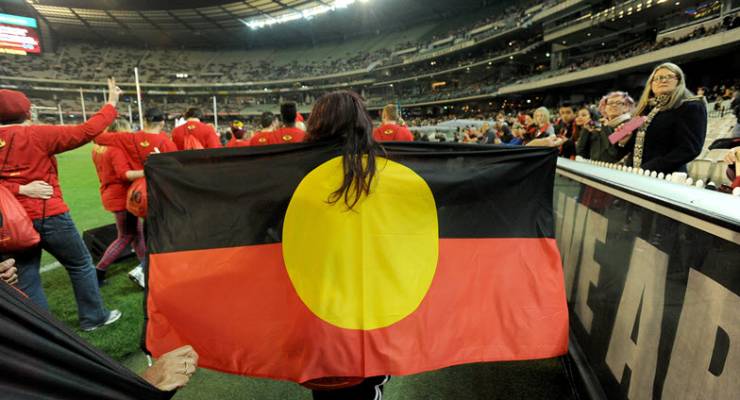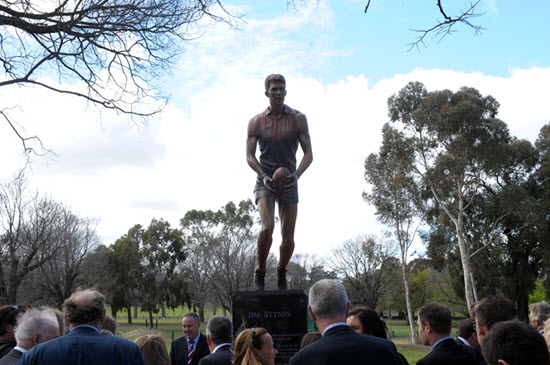
The adults stare hard, looks of panic rip through the crowd. A curiously dressed man in clinical white clothing follows the ball with a dancer’s grace. He turns quickly between two enormous poles, faces the ground, then raises both arms and sharply points his fingers to the field. It’s a goal. People shout in communal ecstasy, while others look away, distraught.
Another Saturday at the MCG with mum, her familiar cries mimicking the overeager crowd all around us. She loved the game and the players, whom she affectionately called her ‘boys’.
Footy echoed through the small red-brick house we moved to after dad left. Mum watched games on the telly live from the MCG almost religiously. By the time I was in high school, my cousin — my mother’s brother’s son, Chance Bateman — had been recruited to Hawthorn. A Noongar boy from York, a small country town in WA, was hitting it big. Family from the west rolled in on the red-eye to watch him play and I saw a new look of hope in my uncle’s eyes. The allure of AFL never grabbed me, but I understood that the ritual roused a passion in my kin that demanded respect.
In thinking about the game, it’s impossible to separate these feelings from the stadium’s location. Nestled in the elite suburb of East Melbourne, the MCG is surrounded by avenues named after early colonial settlers Brunton and Batman; Captain Cook’s Cottage is just a short walk across Wellington Parade. The stadium lies on Crown land, ground that was never alienated from the Commonwealth and remains in the estate of Her Majesty Queen Elizabeth II.
These ties are evident in the name: not Melbourne Football Ground but Melbourne Cricket Ground, after the sport the British brought with them. A game distinctly English with its neat white uniforms, leather ball and willow bat. Shrouded in exclusivity, cricket’s popularity continues today as the elite middle classes rush to put their newborns on waiting lists to become members of the prestigious Melbourne Cricket Club. Australia’s colonial past thrives while we watch footy matches played on Wurundjeri/Boon Wurrung land, in a stadium named after the invaders’ favourite sport.
The late, acclaimed Goernpil poet Lisa Bellear understood how it is we survive among these contradictions. She writes in Beautiful Yuroke Red River Gum:
There are maybe two red river gums a scarred
tree which overlooks the Melbourne Cricket
Ground the survivors of genocide watch
Lisa’s poem reveals two worlds coming together after invasion. Brazen architectural statements dominate the environment, but our knowledge of the land survives among the concrete. Elders of the Kulin nation talk of the ceremonies that took place long before the MCG was built. They share their knowledge of the large red river gums used for making canoes and shields with mob and the broader community.
In recent decades, attempts to engage with Melbourne/Narrm’s history have emerged throughout the sporting precinct. Adjacent to the MCG, vacant land along the Yarra River was transformed into Birrarung Marr, a major park and walkway. Birrarung Wilam, a public artwork by Vicki Couzens, Lee Darroch and Treahna Hamm, creates a twisting pathway to represent the eel, a traditional food of the Wurundjeri and Boon Wurrung people .
To get from Birrarung Marr to the MCG, a bridge was built in 2005 and named after William Barak, a celebrated Wurundjeri activist and artist with living descendants. As you cross, you can hear the voices of Wurundjeri Elders speaking in Woiwurrung, alongside 53 other voices from countries around the world that have made this place home. The rhythms and words offer unity after a difficult past.
But as you get closer to the MCG the atmosphere tightens. The large, grey stadium is surrounded by a litany of statues forbidding in size; the statues encircle the main entrance, upright along tourist trails named “Avenue of Legends” and “Parade of Champions”. Famous sports stars — from Jim Stynes, Ron Barassi, Don Bradman and the regularly disgraced Shane Warne — gaze down at you. Among these champions, there are no black players commemorated in glimmering bronze.

The AFL is full of Aboriginal stars — Cyril “Junior Boy” Rioli, Nathan Lovett-Murray, Gavin Wanganeen, Buddy Franklin, Andrew Lovett and more. But as their striking athleticism radiates, racism follows.
St Kilda star Nicky Winmar lifted his shirt to the crowd in 1994, brazenly pointing to his black skin amidst the glaring racism hurled at him from the Collingwood fans. And in 2013, a 13-year-old girl hissed as Adam Goodes took to the ground, calling him an ape. Tensions flared as some Australians dismissed the girl’s comments as childish banter and TV commentator Eddie McGuire exposed his own racist tendencies by suggesting Adam Goodes promote the musical King Kong. Their actions generated significant media but resulted in little punishment, and Adam retired not long after, leaving fans to wonder if his career was cut short by these words and the booing that plagued his final season.
Yet every year the AFL hosts an Indigenous Round, where the surrounding parks teem with people carrying Aboriginal flags and posters of their favourite black footy stars. Dreamtime at the ’G — the annual match between Essendon and Richmond — sees the stadium erupt with vivid red and yellow lights as the Koori mob dances for the crowd, and a traditional welcome to country by Aunty Di or Aunty Caroline precedes the game.
The Indigenous Round honours Aboriginal players past, present and future. It’s an important gesture, born from difficult beginnings. Dreamtime at the ’G began after former Essendon legend Michael Long walked from his home in Melbourne all the way to Parliament House, 642 kilometres away, in 2004.
What became known as “The Long Walk” grew out of Long’s frustration and determination to get Aboriginal rights back on the political agenda. To honour his work, people gather at Birrarung Marr annually and walk to the ‘G during the Indigenous Round. Crowds of people from all walks of life merge, with mob at the front hoisting an array of banners, vibrantly celebrating culture in this urbanised environment.
While some may revel in the imagery of reconciliation, I also question its worth and meaning given we are the original inventors of the game: a sport that the Gunditjmara called marngrook — knowledge that is still contested, erased from public display.
Acknowledging the origins Australian rules football by calling it marngrook could offer hope, and would be representative of a range of strategies already being introduced by the sports industry. But symbolic gestures initiated by whites are common yet rarely transformative. As Wiradjuri author Jeanine Leane declares in her poem Whitefellas:
they like building things — Whitefellas!
And when they’ve built that
bridge, they should walk back over it to
make sure it’s solid — not just tell us that it is
because we’re over promises.
Conflict haunts the MCG. Moments like the AFL Indigenous Round create optimism, and Birrarung Marr gets us walking towards change, but real justice requires a radical shift — towards a future determined by mob.
This piece is republished with permission from Griffith Review 60: First Things First (Text), ed Julianne Schultz and Sandra Phillips.








Good piece. Thank you. But I think Crown land in Australia is not in the estate of Queen Elizabeth II; the Crown land on which the MCG sits is in fact in the estate of the government of Victoria.
Tell’em their dreaming:- Marngrook not origin of Australian Rules no relationship to Australian Rules at all.
Australian Rules oringinated from early English and Irish settlers, from the Irish game, Gaelic Football is more than 700 years old.
Gaelic football has the bounce up, the ruck, hand ball, flick pass, running bounce, boundary and goal umpires with flags, has the catching too. Before Aussie Rules, Gaelic football had goal and point posts (like AFL) Gaelic football changed their gaol and point post in 1910 to what is now.
Australian Rules is called ‘football’! The word football is English origin over 800 years old.
Is there early white mans newspapers mentioning Marngrook with first recorded game as Australian Rules. There must be copies of Marngrook rules I trying to get a look at, and no early 19 century newspaper articles.
Person from (SBS) NITV Marngrook Footy Show said marking (catching) and kicking is from Marngrook. Is that all!
Not convincing, before white man arrived or settlement about 300 years ago. Gaelic football had marking and kicking so did rugby union.
I’ve only seen Marngrook in a modern day cerermonial act looked nothing like or resembled Australian rules may be rugby yes! There was not even the kicking of the stuffed possum skin and no scoring posts.
The words ‘Dream Time’ was termed by whites, in reference to a black man sleeping it of from getting extremely drunk a alcoholic sleeping it of, ‘dream time’.
Australian Rules originated from our very first English and Irish
https://youtu.be/9FwxjYkuk3g
An article rich in content and poignancy. Where is the statue of Nicky Winmar in his iconic pose? Where is Adam Goodes, former Australian of the Year, now largely absent from the public eye? And where can I lay my eyes on some more Indigenous poetry?!